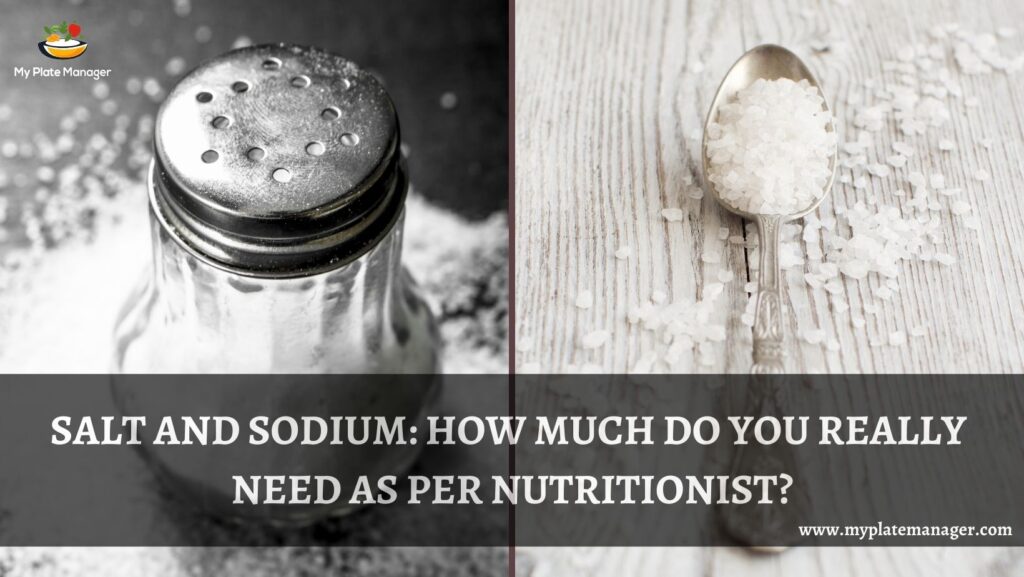Salt and Sodium: How Much Do You Really Need As Per Nutritionist?

Salt and sodium are two terms that are often used interchangeably, but they are not the same thing. Sodium is a mineral that is essential for many bodily functions, while salt is a compound made up of sodium and chloride. Although we need some salt in our diets, consuming too much sodium can have negative health consequences. In this blog post, we will explore how much sodium we really need and the impact of excess sodium consumption on our health.
How much sodium is suggested by Nutritionist?
The amount of sodium suggested by nutritionists like Binny Choudhry varies based on age, sex, and health status. However, the general recommendation for adults is to consume no more than 2,300 milligrams of sodium per day. This amount is equivalent to one teaspoon of salt. However, for people with high blood pressure, diabetes, kidney disease, and other health conditions, the recommended daily intake is much lower – typically between 1,500 and 2,000 milligrams per day.
It is important to note that many people consume much more sodium than they need. The average intake of sodium in the United States is about 3,400 milligrams per day, which is well above the recommended intake. Consuming too much sodium can have negative health consequences, such as high blood pressure, fluid retention, and increased risk of heart disease and stroke.
Therefore, nutritionists from my plate manager recommend being mindful of sodium intake and choosing foods that are low in sodium. This can be achieved by reading food labels, limiting processed foods, cooking at home, being mindful of condiments, and eating out less often. By making small changes to our diets, we can reduce our risk of developing health conditions associated with excess sodium consumption.
Despite these recommendations, the average American consumes much more sodium than they need. In fact, the average intake of sodium in the United States is about 3,400 milligrams per day. This is largely due to the high levels of sodium found in processed and packaged foods, as well as in fast food and restaurant meals.
Consuming too much sodium can have negative health consequences. Excess sodium intake can increase blood pressure, which is a major risk factor for heart disease and stroke. It can also lead to fluid retention, which can cause swelling in the legs, feet, and hands. Additionally, consuming too much sodium can increase the risk of developing kidney disease, osteoporosis, and stomach cancer.
So, how can we reduce our sodium intake? Here are some tips:
Read food labels: The easiest way to know how much sodium you’re consuming is to read the nutrition facts label on packaged foods. Pay attention to the serving size and the amount of sodium per serving. Try to choose foods that have lower sodium content per serving.
Limit processed foods: Processed foods are often high in sodium, so try to limit your intake of packaged snacks, canned foods, and frozen meals. Instead, opt for fresh fruits and vegetables, lean proteins, and whole grains.
Cook at home: Cooking at home allows you to control the amount of sodium in your meals. Try to use herbs and spices to flavor your food instead of relying on salt.
Be mindful of condiments: Many condiments, such as ketchup, mustard, and soy sauce, are high in sodium. Try to limit your use of these condiments or opt for low-sodium versions.
Eat out less often: Restaurant meals are often high in sodium, so try to limit your dining out. When you do eat out, ask for dishes to be prepared without added salt or ask for the sauce on the side so you can control how much you consume.
How Sodium Quantity Helps In Diet Plan For Weight Loss
Sodium quantity plays an important role in a dietitian’s plan for weight loss. High intake of sodium can lead to water retention and bloating, which can result in weight gain. Therefore, reducing sodium intake can help in weight loss by reducing water weight and promoting a healthier body composition.
When planning a weight loss diet, a dietitian will typically recommend reducing the amount of sodium in the diet. The recommended daily intake of sodium for weight loss varies depending on the individual’s health status, but it is generally recommended to consume no more than 2,300 milligrams of sodium per day.
To reduce sodium intake, a dietitian may suggest avoiding high-sodium processed foods and opting for fresh, whole foods instead. Foods that are naturally low in sodium include fruits, vegetables, whole grains, and lean proteins such as chicken and fish. These foods can be incorporated into meals and snacks to help reduce sodium intake and promote weight loss.
In conclusion, sodium is an essential mineral that we need in our diets, but consuming too much can have negative health consequences. By being mindful of our sodium intake and making small changes to our diets, we can reduce our risk of developing health conditions associated with excess sodium consumption.
